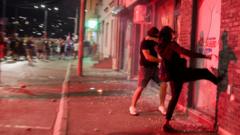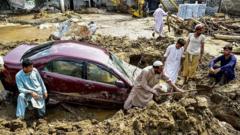What Sparked the Fiery Protests at Serbia's Ruling Party Offices?

Understanding the Recent Unrest in Serbia: Causes and Implications
The recent wave of protests in Serbia has captured the attention of both local and international observers. Initiated by the tragic collapse of the Novi Sad railway station roof, which led to the loss of 16 lives, these protests have evolved into a broader movement against the government led by President Aleksandar Vučić. The increasing clashes between anti-government demonstrators and riot police illustrate a nation grappling with discontent and demands for change. As the situation continues to unfold, it is essential to understand the underlying causes, the responses from various factions, and the implications for Serbia's future.
The Catalyst: The Novi Sad Railway Station Collapse
The protests gained momentum following the structural failure of the Novi Sad railway station in November. This tragic incident not only resulted in numerous fatalities but also unveiled deep-seated issues of corruption and negligence within the government. Many citizens viewed the collapse as a reflection of the broader decay within Serbia’s infrastructure and governance, igniting widespread outrage.
Escalation of Protests
What initially started as calls for accountability transformed into demands for early elections and an end to Vučić's 12-year rule. The protests, which began peacefully, escalated when counter-demonstrations were organized by pro-government supporters. This collision of ideologies has led to violent confrontations, especially noted during the fifth consecutive night of unrest, fueling further agitation among the populace.
The Role of Political Parties and Government Response
The Serbian Progressive Party (SNS), led by Vučić, has faced severe backlash as protestors targeted its offices and symbols. Reports indicate that offices of the SNS were set ablaze in Valjevo, a significant act that symbolizes the protesters' frustration. The government's response has been characterized by the use of riot police, who deployed stun grenades and tear gas to disperse crowds, raising concerns over excessive force and violations of human rights.
Allegations of Police Brutality
Amidst the unrest, serious allegations of police brutality have emerged, with claims of excessive force being used against demonstrators. Video footage circulating on social media purportedly shows police severely beating a protestor in Valjevo, which has sparked outrage both domestically and internationally. Human rights advocates have called for an immediate investigation into these incidents, highlighting the urgent need for accountability in law enforcement.
International Implications and Support for the Government
As the protests continue to unfold, international dynamics have also come into play. Russia has publicly pledged its support for Vučić, framing the unrest as a potential foreign plot against the pro-Moscow administration. This endorsement adds a layer of complexity to the situation, as it intertwines domestic grievances with international relations, potentially impacting Serbia's foreign policy and regional stability.
The Broader Context of Corruption and Governance
At the heart of the protests lies a pervasive sentiment of disillusionment regarding systemic corruption. The collapse of the Novi Sad railway station has come to symbolize years of mismanagement and neglect. Citizens are demanding not only immediate accountability for the incident but also a comprehensive reevaluation of governance practices in Serbia. This unrest signals a growing demand for transparency and political reform, echoing sentiments prevalent across many nations grappling with similar issues.
Public Sentiment and the Demand for Change
The protests reflect a broader discontent with the political status quo. With hundreds of thousands participating at their peak, the movement has gained momentum, drawing diverse groups united by a common goal: the demand for early elections and the end of Vučić’s presidency. The urgency of these demands underscores a shifting public sentiment towards a desire for democratic reforms and accountability in leadership.
The Future of Serbia: Challenges and Opportunities
As Serbia navigates this tumultuous period, several challenges lie ahead. The government must address the growing concerns about civil liberties and human rights while finding a pathway to de-escalate tensions with protestors. The risk of further violence looms large, making it imperative for both sides to engage in dialogue and seek common ground.
Potential Outcomes of the Unrest
The ongoing protests could lead to several potential outcomes for Serbia. Here are some possibilities:
- Political Reforms: Increased pressure from the public may force the government to consider reforms aimed at transparency and accountability.
- Calls for New Elections: If the protests continue to grow, the government may be compelled to hold early elections, potentially reshaping the political landscape.
- Continued Instability: Conversely, if the government maintains its current stance, the situation may escalate into prolonged unrest, further polarizing society.
Conclusion: A Nation at a Crossroads
Serbia is at a critical juncture as it grapples with the implications of widespread public unrest. The tragic events surrounding the Novi Sad railway station have unleashed a wave of discontent that challenges the current political order. As citizens demand change, the government's response will be pivotal in shaping the future of Serbia. The path ahead is fraught with challenges, but it also presents opportunities for meaningful reforms and a renewed commitment to democracy.
FAQs
What triggered the protests in Serbia?
The protests were triggered by the collapse of the Novi Sad railway station in November, which killed 16 people and highlighted issues of corruption within the government.
How has the government responded to the protests?
The Serbian government, led by President Aleksandar Vučić, has deployed riot police to disperse crowds and has faced allegations of excessive force during these confrontations.
What demands are the protesters making?
Protesters are primarily demanding early elections and an end to President Vučić's lengthy reign, along with accountability for the tragic railway station collapse.
What role does international support play in the situation?
International dynamics, particularly Russia's support for Vučić, add complexity to the unrest. This relationship could influence Serbia's political landscape and future governance.
As Serbia navigates this complex and evolving situation, the outcomes will undoubtedly shape the nation’s future. Will the protests usher in a new era of political accountability, or will they lead to further unrest? Only time will tell. #SerbiaProtests #PoliticalReform #HumanRights
```Published: 2025-08-17 02:35:32 | Category: technology



